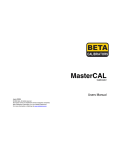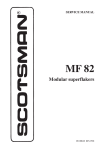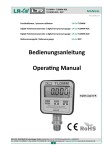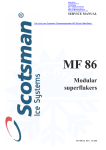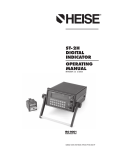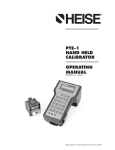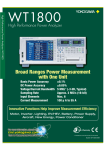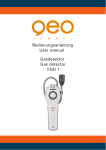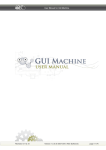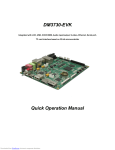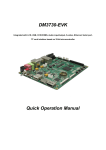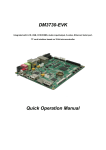Download BetaGauge 320 User Manual
Transcript
MODEL 320 PRESSURE CALIBRATOR & LOOP POWER SUPPLY USER’S GUIDE TABLE OF CONTENTS INTRODUCTION Page General Description………...…………………….4 Model 320 Calibrator…………………..…………4 Loop Power Supply (LPS)………………..………4 Battery Charging………………….………………5 Operation – Model 320 Calibrator Power On Sequence…………………..…………..6 Battery Check - Model 320 Calibrator…...……….9 Battery Check - Loop Power Supply………...……9 Select Key..............................................................10 Zero Key................................................................10 Min/Max Key.........................................................11 Eng Units Key........................................................12 Damp Key..............................................................12 Port Select Key.......................................................13 mA/V Key..............................................................14 % Key.....................................................................14 Trip Reset Key........................................................15 Clear Key................................................................17 Setup Key and Menus.............................................17 User Eng..........................................................18 Batt. Save........................................................20 % Function......................................................21 H2O Ref..........................................................24 Owner..............................................................24 1 Calibration.......................................................26 Trip Detect.......................................................33 Input Functions Volts........................................................................34 Milliamps................................................................34 Pressure...................................................................35 Differential Absolute Vacuum Operation - Loop Power Supply Power On/Off Sequence.........................................36 Battery Check.........................................................36 How To Use The LPS.............................................36 Application Notes Using the Model 320 Calibrator With A Hand Pump.…………………………………….....38 Using the LPS..........................................................41 Pressure Switch Calibration Using Trip Detect.........……………………………………......43 Calibrating a Pneumatic Transmitter.......................44 Calibration Using % Function.................................45 2 Appendix A. Entering Alphanumeric Data..............................47 B. Pressure Conversion Factors..............................48 Specifications Pressure...................................................................50 mA/V.......................................................................51 Environmental.........................................................51 Service Information Warranty.................................................................53 Return For Calibration/Repair................................54 3 INTRODUCTION: GENERAL DESCRIPTON The Model 320 pressure calibrator is a compact, versatile, functionally styled calibrator. The unit is menu driven, so technicians can immediately begin using it to its fullest capabilities without extensive training. The Model 320 faceplate consists of three functional areas: At the top is a two line, alphanumeric liquid crystal display (LCD) for simltaneous indication of pressure and milliamps/volts readings and operator prompting. The center section is a membrane keypad for operator entry. The lower left section contains recessed input jacks for connecting the supplied test leads to the device being calibrated. The pressure connectors are at the lower end of the case and are 1/8” FNPT. The Loop Power Supply (LPS) is an option that provides 24 VDC to power the device under test if 4 desired. The LPS is stored in a pouch under the Model 320 calibrator for easy access. BATTERY CHARGING Units are shipped with the internal batteries in an uncharged state. Before using the Model 320 or the LPS as a portable unit, it is necessary to charge the batteries for a minimum of 14 to 16 hours. The calibrator battery charger is a wall plug-in type (see below) that connects to a jack on the right-hand side of the instrument. Battery operation time is 50 hours, typically for the Model 320 and 6 hours nominal at 20 milliamps for the LPS. 5 OPERATION: The Model 320 calibrator is user friendly and menu driven. A first time user can normally start operating the unit with few or no instructions. The following information is intended to provide a detailed understanding of the unit. POWER ON SEQUENCE The calibrator is turned on or off by pressing the On/Off key. Each time it is turned on, a series of internal tests and calibrations are performed. The start-up procedures provide a pass/fail test of certain internal circuitry. If the tests determine the unit has an internal failure, a fault message is displayed and the unit will not operate. Refer to the Service Information on page 54 for information on how to contact the factory. The start-up calibrations provide for dynamic recalibration of the internal calibrator support circuitry, by applying the primary reference voltages to points in the circuitry and recording the readings as references for further measurements. The start-up 6 auto calibration does not in any way affect the primary calibration done at the factory or at a field metrology lab using available software and suitable standards. During the time the start-up tests and calibrations are being performed, certain informational displays are presented to show the status of the calibrator. The first message displayed will be: Beta Gauge 01/04/94 This indicates the date in MM/DD/YY format of the last factory calibration. The example indicates the Model 320 was calibrated on Jan. 4, 1994. If the unit has been recalibraed in the field, the date will be displayed in a MM-DD-YY format. See page 26 for a description of the calibration procedure. The next display will be: property of YOUR NAME HERE 7 This gives the name of the owner of the calibrator. The preceding display shows the default setting as the calibrator is shipped. The name can be changed through the operator setups. See page 24 for how to change the owner’s name. The next display will be: Auto Calibration in progress This display will remain until the internal tests and calibrations are finished. If the auto calibration message fails to clear, the unit must be returned for service. See page 54 for details. The next display will be the functions that had been selected when the calibrator was last used: inH2O 0.0 mA 0.000 This display indicates the calibrator is operating properly and is ready to go to work. 8 BATTERY CHECK The Bat Ck key may be pressed at any time after completion of the calibrator startup routine to diplay the current batttery voltage for approximately 1 second before the normal display returns. The current input funciton is not disturbed by making a battery check measurement. The battery voltage of the Model 320 calibrator should be between 5.3 and 4.6 volts. When the voltage falls below 4.8 volts, a warning message is displayed approximately every minute. When the voltage falls below 4.6 volts for 1 minute, the calibrator will turn itself off to prevent damage to the batteries due to possible reversal. The batteries of the LPS are checked by plugging the cable provided with the LPS into the battery charger jack located on the side of the LPS. The other end of the cable should be plugged into the Model 320 V input. When voltage is selected on the keypad, the LPS battery voltage will be displayed on the Model 320. 9 The LPS battery voltage should be between 10.6 and 9.2 volts, indicating a full charge. When the voltage falls below 8.8 volts, the LPS will turn itself off to prevent damage to the batteries due to possible cell reversal. SELECT KEY The Select Key is used for two functions. First, while in Setup, pressing Select will switch the dispay from two sets of menu screens. Second, Select is used in the field calibration described on page 26. ZERO KEY When the Model 320 is first turned on, a small zero offset may appear. Pressing the zero key wil eliminate it. A warm up of up to four minutes may be required to achieve nominal accuracy. For absolute pressure sensors only, the following procedure may be used. Press the Zero Key. The calibrator will request the user to enter the calibration access code (found on the factory calibration data sheet.) After entering the code and pressing the enter key, the calibrator will prompt the user to enter the new zero (actual barometric 10 pressure). A barometric standard of at least .025% accuracy should be used to determine atmospheric pressure. When entering this value, proper decimal place entry must be observed. The “Zero” key is inactive during user calibration. Only numeric entry (9) is active in this mode. MIN/MAX KEY The Model 320 calibrator constantly monitors the displayed readings and stores the minimum and maximum values internally. Pressing the Min/Max key will cause the minimum and maximum values to be displayed. The maximum values will be displayed on the top line and the minimum values will be displayed on the bottom line. Pressing the Min/Max key a second time will return the Model 320 to a normal display mode and will reset the minimum and maximum values to the current reading. The minimum and maximum values are also reset whenever a new function or engineering unit is selected. 11 ENG UNIT KEY The Eng Unit key allows the user to select any of the 8 standard or 1 user definable engineering units to be activated for the pressure display. Each time the Eng Unit key is pressed, the next engineering unit is selected. Engineering units which exceed PSI resolution, will not be valid. Example, 50,000 counts, when converted from the 5000.0 PSIG converted to mmHg equals 258,575 mmHg. This exceeds 50,000 counts and will not be an active unit of measurement. If a user defined engineering unit has been entered, it is displayed as the 9th entry. The user defined entry can always be identified by a “u” in the first position, followed by the name. The user defined engineering uits are configured from the operator setup functions (UsrEng). DAMP KEY The Damp key alternately enables or disables damping of the displayed pressure measurements. When damping is active, the Model 320 displays a running average of the last 16 measurements rather 12 than the instantaneous values. This feature is useful when measuring pressures that are pulsating or otherwise unstable. The Model 320 makes 2-3 pressure measurements per second. When the Damp mode is active, the Model 320 updates the display each time a measurement is made. The displayed is the average of the last 16 measurements. PORT SELECT KEY The Port Select key is used to select either or both of the pressure ports to be displayed on dual sensor 320 calibrator models. If the Model 320 is equipped with dual pressure sensors, pressing the Port Select key will alternately select the left port, the right port, or both ports. If both ports are selected, the Model 320 will display both pressures simultaneously but milliamps or volts cannot be displayed. If one port is selected, the Model 320 will display one pressure and either milliamps or volts. 13 MA/V KEY The mA/V key will alternate the electrical measurement being displayed between milliamps and volts. % KEY Pressing the % key will cause the Model 320 calibrator to switch from displaying in the selected engineering units to displaying the readings as a percentage. The Model 320 percent function is a powerful feature that greatly simplifies the calibration of I/P, E/P, P/I, P/E AND P/P transmitters. When the percent function is active, the input to the instrument being calibrated is displayed as a percent of full scale, and the output from the instrument being calibrated is displayed as an error percent. To utilize the percent function, the operator should first utilize the setup function (% func) to enter the desired zero and full scale values required for the calibrator. This is described on page 21. 14 Once the proper zero and full scale values have been entered, the operator presses the % key to activate the percent function. The zero and span adjustments to the transmitter can now be quickly adjusted by applying aproximately 0% and 100% inputs to the transmitter as shown on the display, and adjusting the output for 0% error as shown on the display. After the zero and span adjustments have been made, the linearity can be quickly checked by applying various intermediate inputs and noting the error directly in percent. If there is no error, 0% will be displayed for any pressure input. The application note on page 45 gives examples for using the percent function. Pressing the % key a second time will return the display to the selected engineering units. The percent mode is also terminated if a new function or engineering unit is selected. TRIP RESET KEY The Trip Rst key is used in conjunction with the trip 15 detect mode that is available through the setup menus. When trip detect is active, the Model 320 calibrator will monitor the electrical measurement for a significant change of state. When a change of state is detected, the last pressure measurement is frozen on the display, and the message “tripped” is displayed over the electrical measurement. When the Trip Rst key is pressed, the Model 320 will resume displaying the instantaneous pressure and monitoring for a change of state at the electrical terminals. The message “ready” will be displayed over the electrical measurement. A change of state is signified by a 10% change in either the volts or milliamps reading. When trip detect is active, voltage measurements will be made on the 30 V scale and milliamps measurements will be made on the 50 mA scale. The Model 320 makes 2-3 electrical measurements per second. To guarantee that the change of state will be detected, the change must exist for a minimum of ½ second. For a hook-up diagram, refer to the application note on page 43. 16 CLEAR KEY The Clear key allows the operator to re-enter an incorrect numeric entry. When the Model 320 calibrator is expecting a numeric entry, a ????? prompt is displayed. As numeric keys are pressed, the value is echoed on the display. If a keying error is made, press Clr to cancel the value entered and return to the ????? prompt. SETUP KEY AND MENUS The Setup key allows the user to perform certain custom operations with the Model 320 calibrator. When the Setup key is pressed, the display will display two menus of items that are configurable by the operator. Pressing the Select key will bring up a second menu display. Pressing the Select key again will bring back the original menus. Pressing the Enter key will clear the Setup mode and the Model 320 will resume its normal display. All of the user setup parameters are retained when the Model 320 is turned off. 17 Next to each menu in Setup is a number. Pressing that number on the keypad allows the operator to configure that specific item. 1 = UsrEng (User Defined Engineering Unit) This allows the user to enter a custom engineering uit coversion. The conversion factor to be entered is the conversion from 1 PSI. Up to 6 significant digits can be entered, however, the Model 320 calibrator will display a maximum of 50,000 counts. The Model 320 will display the user defined engineering units with the same number of decimal places that were entered as the conversion factor. Enter the desired conversion and press Enter. If you make a mistake while entering the value, press the Clr key to allow the value to be re-entered. If the Clr key is pressed while the ????? prompt is displayed, the user defined engineering units are made invalid, and will not be displayed when the Eng Unit key is pressed. 18 After the conversion value is entered, the name for the new units can be entered. The name consists of 1 to 5 alphanumeric characters that are selected by entering their decimal equivalent. Appendix A gives additional information on this. If you do not choose to enter a name, press the Clr key and a default name of USER will be applied. As an example, to set up a user defined scale for standard atmospheres where 1 PSI = .06805 atmospheres, enter the following: enter 1PSI equiv ????? Enter .06805 and press the Enter key. enter units name USER ????? 19 The name shown in the lower left is the last name that has been entered. To enter Atmos as the name, you would enter the following values (press Enter after each value) 65, 116, 109, 111, 115. (See Appendix A). Press <Ent > for any undesignated letter to exit the routine. If all 5 are used, exiting will be automatic after the fifth entry. To access the new user defined units, press the EngUnit key until Atmos is displayed as the engineering units. 2 = BattSv (Battery Save) The battery save feature will turn the calibrator off if there is no keyboard activity for 30 minutes. This prevents running the batteries down if the unit is accidentally turned on, or if the unit is left unattended. Battery Save should be on unless you have a specific application where the calibrator needs to run unattended for greater than 30 minutes. New units are shipped with Battery Save “On”. Battery Save 1 = On 2 = Off 20 Press either 1 or 2 using the numeric keys to turn battery save on or off. 3 = %func (Percent Function) The percent function allows the operator to specify the zero and full scale values for a calibration to be performed. The Model 320 calibrator will then automatically calculate the percent of error based on this information. When the Percent Setup is selected, the operator is prompted to enter the zero and full scale values for the input to the transmitter and the zero and full scale values for the output from the transmitter. The first prompt screen, for entering the transmitter input zero value is: enter input z + 0 ????? The current value is shown in the lower left. If there is no change required, simply press Enter to accept the current value. Otherwise, enter the desired value and press Enter. 21 Note that the input will be a pressure value for P/I or P/P transmitters, and will be a voltage or milliamp value for an I/P or E/P transmitter. After the input zero is entered, the next screens will prompt for input full scale, output zero, and output full scale: enter input FS + 100 ????? enter output z + 4 ????? enter output FS + 20 ????? After the zero and full scale values are entered, the operator will be prompted to define the type of instrument being calibrated. 22 1 = I/P 3 = P/P 2 = P/I Select I/P for transmitters that accept a current or voltage as an input and produce a pressure as an output. Select P/I for transmitters that accept a pressure as an input and produce a current or voltage as an output. Select P/P for pneumatic transmitters that accept a pressure as and input and produce a pressure as an output. The P/P selection is only available on a Model 320 that is equipped with two (2) pressure sensors. If the P/P selection is made, an additional prompt screen will be displayed: 1 = input on left 2 = input on right Select “1” if the pressure input to the pneumatic transmitter is being measured on the left port of the Model 320. 23 Select “2” if the pressure input to the pneumatic transmitter is being measured on the right port of the Model 320. After the percent function setup is completed, the function is activated by pressing the % key. 4 = H2Oref (H2O Reference Temperature) The H2O Reference refers to the temperature correction for inches and centimeters of water measurements. There are three choices: 20 °C, (ISA Standard); 4 °C, (Scientific Standard); and 60 °F, (American Gas Association Standard). Press the number for the desired temperature correction. 1 = 20C 3 = 60F 2 = 4C 5 = Owner (Change Owner’s Name) The Model 320 calibrator contains a security feature that allows the owner to enter a name or other 24 identifying information into the calibrator’s nonvolatile memory. The owner’s name cannot be changed unless the operator knows the unit's access code. The access code is unique to each calibrator and is printed on the individual calibration sheet that is shipped with each calibrator. When a new calibrator is received, the owner should enter the desired owner name and file the access code in a safe place for future reference. DO NOT keep the access code with the calibrator. When the owner setup is selected, the operator is prompted to enter the access code. Enter the access code from the calibration sheet and press Enter. If the correct code is entered, the next display will be the current owner name on the top line. YOUR NAME HERE The name of the owner can be any alphanumeric combination of characters up to a maximum of 16. The characters are assigned by entering the decimal 25 value of the desired character. Appendix A lists the values for each character. To advance to the next position without changing the existing character, press Enter while the ????? prompt is showing. To back up to previous position, press Clr while the ????? prompt is showing. Press the < ENT > key repeatedly to exit the routine. 6 = Calib (User Calibration) The Model 320 is a fully digital instrument that employs advanced software correction algorithms to allow the instrument to be fully calibrated without the use of any analog adjustments, i.e., trim pots. The Model 320 allows all parameters except temperature compensation to be adjusted from the keypad. CALIBRATION SHOULD ONLY BE ATTEMPTED BY QUALIFIED PERSONNEL HAVING SUITABLE METROLOGY STANDARDS AVAILABLE. The parameters that are adjusted and the required reference sources are listed below: 26 Function to calibrate Volts In mA In pressure; zero, span linearity Required ref source 10VDC ± .01% 20mA ± .01% pressure at 0%, 25%, 50%, 75%, 100% of scale. Accuracy should be 3 times better than the Model 320 range. The sequence required to perform the calibrations is (1) apply the required calibration source, (2) observe the reading on the Model 320, (3) if the reading on the 320 is outside of the required tolerance, enter the desired reading. If the reading is correct, proceed to the next calibration step. The pressure ranges are calibrated using the engineering units that were selected when calibration mode is activated. Ensure that the proper engineering units are selected before entering the calibration mode. Also be sure to select the proper temperature compensation value if inches of water column are selected. The temperature compensation value should be the same for the Model 320 and the pressure source. 27 To place the Model 320 into the calibrate mode, press 6 (user cal) while in set up mode, screen number 2. The unit will prompt for the access code to be entered. enter access code ????? Enter the calibration access code from the individual calibration data sheet that is supplied with the unit. If the correct access code is entered, the Model 320 will enter the calibration mode as shown below. volts user cal + 10.000 volt in The following keys are active during calibration mode. 28 Select – proceed to the next calibration step. Clr – If depressed while a user calibration step is active, ????? will be displayed prompting the user to enter the new calibration value from calibration source. If depressed during numeric entry, it functions as the normal clear entry key. Enter and number keys – used to enter calibration values Calibration values are entered as counts without any decimal places. For example, when calibrating milliamps, the display might show 19.997. If the calibration source is 20.000 mA, you would press Clr and then enter 20000. The followwing table lists the calibration steps and the required procedure to use. The basic procedure for each step is to: 1. Apply the requested input source. 2. Observe the reading on the Model 320. 3. If the reading is outside of limits, press Clr and enter the correct value. 29 4. If the reading is within the required limits, press Select to progress to the next step. After the last calibration step, the user is prompted to enter the date. THE CALIBRATION DATA IS NOT SAVED UNTIL A DATE IS ENTERED. DETAILED PROCEDURE 1. Insure that the Model 320 to be calibrated by means of the user calibration mode is temperature stable at 25 degrees C ±5 degrees. Any deviation will induce temperature compensation correction inaccuracies. 2. Press the “set up” key. Select 6 from menu #2. To display the second menu screen, press the select key while in the setup mode. Next the user will be prompted to enter the user calibration code from the unit’s calibration data sheet. When the correct access code is entered from this data sheet, functions to be calibrated will be displayed in the following order. Function Volts input Milliamp input Required Reference Value 10.000 20.000 30 Left pressure zero Vent for gauge, and gauge vacuum, 0.003 PSI or less for absolute Left pressure Span Left pressure 25% Left pressure 50% Left pressure 75% (enter date single sensor) Right pressure zero FS – range dependent 25% of FS 50% of FS 75% of FS Right pressure Span Right pressure 25% Right pressure 50% Right pressure 75% (enter date dual sensor) Vent for gauge, and gauge vacuum, 0.003 PSI or less for absolute FS – range dependent 25% of FS 50% of FS 75% of FS If you have entered the user calibration mode and do not wish to change any calibration values simply press the Select Key to bypass each step. Bypassing each step with the Select Key will preserve the original calibration providing that the Clr Key has not been depressed at any point. Enter the date per prompt to 31 exit the calibration mode. To calibrate electrical or pressure functions proceed as follows. 3. Apply a 10 volt signal to the volts input. If adjustment is required press the CLR key. Next, enter the correct reference voltage value. Calibration values are entered in counts without any decimal places. Enter 10000 for 10.000 volts. Repeat the sequence if necessary to acquire a proper calibration. When you are satisfied with the calibration press the Select key to proceed to the next calibration step. 4. The next screen will display the milliamp calibration. Calibrate the full scale mA at 20.000 mA. Use the CLR and Select key as previously described. 5. The next prompt will be for the left pressure port. The sequence will be zero, span, 25%, 50%, and 75% of full scale. When using a dead weight tester the exact percent of scale may not be possible. The percent of scale need not be exact but, should be as close as possible. Many times only the zero and span will need adjustment. As in the previous sequences, apply the correct reference, use the Clr key to clear the reading, enter the new reference reading in counts without decimal places, press “ent” to enter the new value, and select key when finished to proceed to the 32 next calibration step.. points to be calibrated. Repeat this process for all At the end of the pressure calibration sequence you will be prompted for the current date. The format is MMDDYY. CALIBRATION DATA IS NOT SAVED UNTIL A DATE IS ENTERED. 7 = Trip (Trip Detect) The trip detect setup function allows trip detect to be turned on or off: trip detect 1 = on 2 = off The operation of the trip detect function is explained on page 15 and 16 under the Trip Rst key. 33 INPUT FUNCTIONS VOLTS The Model 320 measures voltage at the volts terminals at the lower left corner of the keypad area. The negative terminal is common to volts and milliamps measurements. To measure voltage, press the V/mA Key, until Volts is displayed on the upper line of the LCD display. If you have a Model 320 wih 2 pressure sensors, you must first ensure that volts/mA are available by pressing the Port Select key. There are 2 voltage ranges and the Model 320 autoranges between them. The ranges are 0-10.000V and 0-30.00V. When the input voltage exceeds approximately 11 volts, the Model 320 will change to the 30V scale. When the input voltage falls below 10.5 volts, the Model 320 switches back to the 10V scale. MA The Model 320 measures current at the mA terminals 34 at the lower left corner of the keypad area. The negative terminal is common to volts and milliamps measurements. To measure current, press the V/mA Key, until milliamps is displayed on the upper line of the LCD display. If you have a Model 320 with 2 pressure sensors, you must first ensure that volts/mA are available by pressing the Port Select key. There are 2 current ranges and the Model 320 autoranges between them. The ranges are 020.000mA and 0-50.00mA. When the input current exceeds approximately 22 mA, the Model 320 will change to the 50mA scale. When the input current falls below 21 mA, the Model 320 switches back to the 20mA scale. PRESSURE The model 320 measures pressure at the 1/8” FNPT port at the base of the unit. Units with 2 pressure sensors or one differential sensor will have 2 ports. The full scale pressure for the individual port(s) is shown at the base of the keypad, directly above the pressure port(s). 35 The Model 320 does not employ any overpressure relief bypass. The maximum overpressure for the various sensors is given in the specifications section. Exceeding these pressures can cause a shift in the calibration of the unit or permanent damage to the sensor. OPERATION LOOP POWER SUPPLY The Loop Power Supply (LPS) contains eight (8) AA Ni-Cd batteries that provide power to a DC to DC converter. This converter boosts the battery voltage (10.6 to 9.2) to 24 VDC ±5%. The LPS is intended for use as a power suppy for any two wire, 4 to 20 milliamp instrument requiring 24 VDC power. Battery life is 6 hours nominal at 20 milliamps. Full specifications can be found on page 51. The LPS is designed to turn itself on and off automatically, based on current demand. When a series loop exists at the LPS loop power jacks calling for .5 milliamps or greater, the LPS will automatically 36 turn on. Open the loop and power down occurs. This allows for maximum battery life by not allowing the unit to be left in the on mode accidentally. The LPS can be used with or without the Model 320 calibrator. When the test leads are connected from the LPS Loop Power connections to a device requiring power, the LPS automatically turns itself on and provides 24 VDC. Breaking the connections causes the LPS to automatically turn itself off, preventing needless battery drain. To use the Model 320 calibrator with the LPS, simply plug the special connector provided with the LPS from the plug marked “Calibrator mA Input” on the LPS to the Model 320 milliamp input terminals. This automatically puts the Model 320 in series with the 4 to 20 mA loop. Reference page 42. The Batteries of the LPS can be checked by plugging the same special cable provided with LPS from the plug marked “Battery Charger” on the LPS, to the V input jacks on the Model 320. When voltage is selected on the keypad, the LPS battery voltage will be displayed on the Model 320. 37 The LPS battery voltage should be between 10.6 and 9.2 volts. When the voltage falls below 8.8 volts, the LPS will automatically turn itself off to prevent damage to the batteries due to possible cell reversal. The battery charger used for the Model 320 should be used for the LPS. APPLICATION NOTES USING THE MODEL 320 PRESSURE CALIBRATOR WITH A HAND PUMP 1. Safely take the instrument to be tested out of service, equalize it, and vent it. 2. Vent the low side to atmospere and connect the high side as shown, being very careful that there are no leaks. Note: It is best to drain the high and low sides to prevent liquids from entering the calibration tubing. 3. Connect the test leads to the Model 320 mA input and to the instrument to be calibrated to form a series loop. 38 4. Turn on the Model 320 and select mA. 5. Select the desired engineering units by pressing the Eng Unit button. 6. Press the Zero button to zero the Model 320. Checking zero several times in the first 4 minutes of operation is recommended. 7. Proceed with calibration. 39 Transmitter Calibration Using Pressure Pump 40 USING THE MODEL 320 PRESSURE CALIBRATOR AND LPS WITH A HAND PUMP 1. Safely take the instrument to be tested out of service, equilize it, and vent it. 2. Vent the low side to atmosphere and connect the high side as shown, being very careful that there are no leaks. Note: It is best to drain the high and low sides to prevent liquids from entering the calibration tubing. 3. Connect the special connector to the Model 320 mA input. 4. Connect the test leads to the LPS at the loop power connection and to the instrument to be calibrated, being careful to observe the correct polarity. 5. Turn on the Model 320 and select mA. 6. Select the desired engineering units by pressing the Eng Unit key. 7. Press the Zero key to zero the Model 320. Checking zero several times in the first 4 minutes of operation is recommended. 8. Proceed with calibration. 41 Transmitter Calibration Using Loop Power Supply (LPS) 42 Pressure Switch Calibration Using Trip Detect 43 Calibration of a Pneumatic Flow Transmitter 44 CALIBRATION USING % FUNCTION You can use the % Function to calibrate a P/I pressure transmitter. For this example we will calibrate a pressure transmitter that has a manufacturer’s range of 0-50 PSIG. The desired calibration will be 0-25 PSIG for a 4-20 mA output. We are using a Model 320 with a 30 PSIG range. Press Setup-3 to enter the percent function setup mode. Enter the following values in response to the prompts: Enter input Z 0 Enter input FS 25 Enter output Z 4 Enter output FS 20 1=I/P 2=P/I 3=P/P 2 The Model 320 will then exit the setup mode and resume a normal display. Press the % key to activate the percent function. With the pressure vented to the transmitter, you should see a display similar to this: % scale +0.00 %error -1.25 45 This shows that the pressure input to the transmitter is at +0.00% of scale, and the milliamp output is 1.25% low. If the % of scale reading is not 0%, you can press the Zero Key to acquire a new zero reference. Change the zero adjustment on the transmitter until the % error reading is 0%. Now apply pressure to the transmitter and Model 320 and adjust the pressure until the % scale reading is 95-100%. Change the span adjustment on the transmitter until the error reading is 0%. Repeat the zero and span adjustments until the % error readings are within the accuracy required. Since the Model 320 calculates the % of error at any pressure input, the adjustments can be quickly made. After the zero and span adjustments are made, the linearity can be quickly checked at 25, 50 and 75% of scale and the error % read out directly. 46 APPENDIX A Entering Alphanumeric Data The user is required to enter alphanumeric data when changing the owner’s name and configuring user defined engineering units. Since the Model 320 does not have an alphanumeric keyboard, the characters are entered by using the decimal equivalent of each character from the table below. 32 33 34 35 36 37 38 39 40 41 42 43 44 45 46 47 48 49 50 51 52 53 54 55 sp ! “ # $ % & ‘ ( ) * + , . / 0 1 2 3 4 5 6 7 56 57 58 59 60 61 62 63 64 65 66 67 68 69 70 71 72 73 74 75 76 77 78 79 8 9 : ; = ? @ A B C D E F G H I J K L M N O 80 81 82 83 84 85 86 87 88 89 90 91 92 93 94 95 96 97 98 99 100 101 102 103 P Q R S T U V W X Y Z [ ¥ ] ^ _ a b c d e f g 104 105 106 107 108 109 110 111 112 113 114 115 116 117 118 119 120 121 122 123 124 125 126 127 h i j k l m n o p q r s t u v w x y z < 1 > → ← 47 APPENDIX B Pressure Conversion Factors The factors used by the Model 320 Calibrator to convert from PSI to other enineering units aare listed below. 2.036 51.715 6.8948 68.948 .068948 27.681 27.707 27.730 70.310 70.376 70.433 “Hg mmHg KPascals milliBars Bars “H2O “H2O “H2O cmH2O cmH2O cmH2O @ 0ºC @ 0ºC @ 4ºC @ 60ºF @ 20ºC @ 4ºC @ 60ºF @ 20ºC If conversions at full scale exceed the maximum 50,000 count resolution, the converted engineering unit becomes invalid and will not display. 48 SPECIFICATIONS MODEL 320 PRESSURE CALIBRATOR AVAILABLE RANGES: Gauge Vacuum Absolute Differential PSIG PSIG PSIA PSID*** 0-0.39** 0 to –1** 0-15* 0-1** 0-1** 0 to –5** 0-30* 0-5** 0-5* 0 to –15** 0-50* 0-30** 0-7.8* 0-50** * Prior to Jan. 2002, these ranges were 0-15* typically non-isolated sensors that required 0-30* clean, dry, non-corrosive air or gasses for 0-50* pressure media. As of Jan. 2002, all 0-100* aabsolute ranges and positive gauge ranges from 5 PSI full scale through 5k are isolated 0-150* sensors where the wetted material is 316SS. 0-300 0-1000 ** These ranges are non-isolated sensors that 0-1500 0-3000 0-5000 require clean, dry, non-corrosive air or gas for pressure media. *** Maximum static pressure 200 PSIG Plus deviations only. All ranges come standard with eight engineering units readout selection, keypad selectable by the operator (inH2O, inHg, PSI, kPa, mmHg, mbar, cmH2O, bars, plus a user defined scale). [see appendix B] 49 ACCURACY: * PRESSURE: ±(%Rdg, ±%FS, ±1 LSD) %Rdg %FS PSI Res. PSI Range 0.39 0.07 0.03 0.0001 1 0.07 0.03 0.0001 5 0.05 0.02 0.001** 7.8 0.05 0.02 0.001 15 0.05 0.02 0.001 30 0.05 0.02 0.001 0.05 0.02 0.001 50 100 0.05 0.02 0.01 150 0.05 0.02 0.01 0.06 0.03 0.01 300 1000 0.06 0.03 0.1 0.07 0.03 0.1 1500 0.1 0.1 3000 5000 0.1 0.1 * Includes the effects of non-linearity, repeatability, hysteresis, and temperature for 180 days. ** Sensors manufactured prior to 1997 may display 4 decimal places. 50 ELECTRICAL: ±(%FS, ±1 LSD) Standard Units: Res. Range Units %FS 0-10 V 0.025 0.001 0-30 V 0.1 0.01 0-20 mA 0.025 0.001 0-50 mA 0.1 0.01 CSA Approved / Intrinsically Safe Units: Range Units %FS Res. 0-10 V 0.05 0.001 0-30 V 0.1 0.01 0-20 mA 0.05 0.001 0-50 mA 0.1 0.01 IMPEDANCE: Volts 1 MegaOhm mA 25 Ohms RESOLUTION: 50,000 counts maximum, depending on range (see accuracy table) and engineering unit (see appendix B). TEMPERATURE: Operating: 0 to 50ºC (No Effect on Accuracy within this range.) 51 Storage: -30 ºC to 50ºC, with batteries; -30 ºC to 70 ºC without batteries. OVERPRESSURE: Operating, without damage or calibration shift: 0-100 psi 300% of sensor range 300-1500 psi 150% of sensor range 2000-5000 psi 150% of sensor range or 6100 psi whichever is less. Custom order ranges will deviate. Consult factory for overpressure specification. PRESSURE FITTINGS: 1/8” FNPT 316SS. ELECTRICAL CONNECTIONS: Miniature recessed banana jacks. DISPLAY: Simultaneous pressure and electrical on 32 character alphanumeric LCD display. BATTERY: Ni-Cd (four AA cells); 50 hours nominal at 25 ºC, rechargeable. BATTERY CHARGER: 115 VAC, 50/60 Hz, wall mount; 12-14 hours for full charge; optional 12 VDC charger available. LOOP POWER SUPPLY MODULE: Rechargeable Ni-Cd batteries (eight AA cells); 6 hours nominal @ 20 mA @ 25 ºC; voltage, 24 VDC ±5%. 52 WARRANTY Beta Calibrators devices are warranted to be free from all latent defects in material and workmanship under normal use and service. Should any of Beta Calibrators’ devices to be found within one (1) year from date of shipment to be defective, Beta will repair such part and return to buyer FOB Beta’s plant or will furnish FOB Beta’s plant a similar part to replace it, provided written notice of such defect is given to Beta within ten (10) days after the discovery of such defect and provided the original part is returned to Beta’s plant with transportation charges prepaid. THE FORGOING WARRANTIES ARE IN LIEU OF ALL OTHER WARRANTIES, EXPRESSED OR IMPLIED, INCLUDING BUT NOT LIMITED TO THE IMPLIED WARRANTIES OF MERCHANTABILITY AND FITNESS FOR A PARTICULAR PURPOSE. 53 SERVICE INFORMATION Return for calibration, recertification or repair. It is recommended that each calibrator be recalibrated and/or recertified on a 6 month basis, against precision standards that are traceable to the National Institute of Standards and Technology. All returns should include a statement on the work requested and the exact address to which the unit should be returned. Beta Calibrators will return units on a prepaid basis. RETURN AUTHORIZATION All equipment and/or parts to be returned to Beta Calibrators for repair or credit must have a Beta Calibrators Return Authorization Form. This form will be issued by the Beta Calibrators Customer Service (972) 241-2200 for credit, or the Beta Calibrators Service Department (800) 537-2181 for repair. 54 Website: www.betacalibrators.com Email: [email protected] When calling for a form, please provide your Purchase Order Number and an explanation of why equipment and/or parts are being returned. After the form has been obtained, return equipment along with the form and a copy of your Purchase Order. This will ensure rapid service and/or credit. Ship Prepaid To: Beta Calibrators 2309 Springlake Road, Suite 600 Farmers Branch, Texas 75234-5875 Attention: Service Department 55 2309 Springlake Road, Suite 600 Farmers Branch, TX 75234-5875 USA Copyright 2002 Beta Calibrators





























































